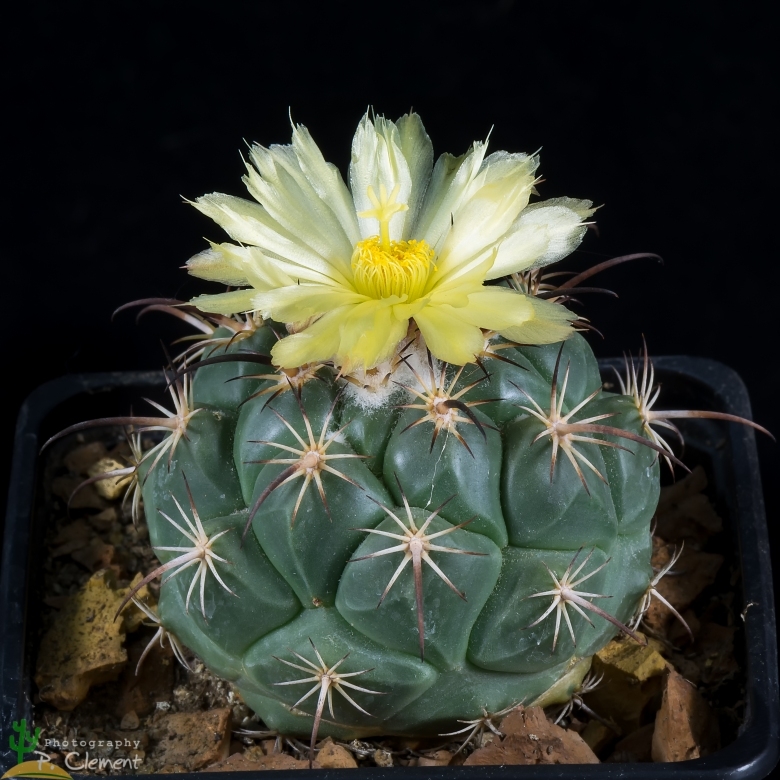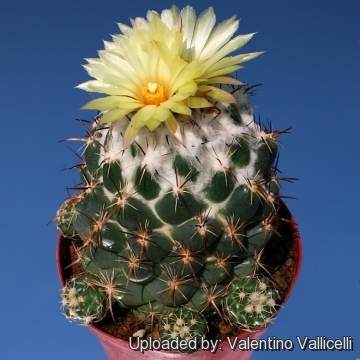Accepted Scientific Name: Coryphantha longicornis Boed.
Monatsschr. Deutsch. Kakteen-Ges. 11: 249, fig. 1931

Coryphantha grandis Photo by: Peiffer Clement
Origin and Habitat: Coryphantha grandisSN|10217]]SN|10217]] grows in the broad valley of the Rio Nazas stretching east from El Palmito, Durango, Mexico.
Habitat and ecology: This species grows on limestone rocky soil, mostly on the south sides of hills in rather sparse grass. During the rainy season, the grass would give the plants a little shade. But during most of the year it would be nearly full sun conditions.
Synonyms:
See all synonyms of Coryphantha longicornis
back
Accepted name in llifle Database:Coryphantha longicornis Boed.Monatsschr. Deutsch. Kakteen-Ges. 11: 249, fig. 1931Synonymy: 2
back
Common Names include:
SPANISH (Español): Biznaga de Piña
Description: Coryphantha grandisSN|10216]]SN|10217]] is a large form of Coryphantha longicornisSN|10216]]SN|10216]] with shorter central spines described by Lew Bremer in 1978 from N. Durango, Mexico. Coryphantha longicornisSN|10216]]SN|10216]] is quite variable especially regarding the length of the lower central spine and body size. The plants with shorter central spines and larger stems with more spiral ribs are sometime referred as Coryphantha grandisSN|10217]]SN|10217]], while those with longer centrals are referred as Coryphantha longicornisSN|10216]]SN|10216]]. (But this classification is arbitrary and intermediate form are commonly found either in habitat and in cultivation) In the original description, the data given for the body size of C. grandis is: spiral count of 13:21 for the tubercles, and body to 16 cm high and 14 cm in diameter. But most plants in the field do not match the high spiral number given for the type plant. Usually varying from a count of 5:8 and 8:13. The tubercle size on the plant with 5:8 count is somewhat .larger than the other 3 with 8:13 count. The plants, within a very small variance, have a body size size of 10 cm. tall by 13 cm. in diameter. It can be assumed that a very large plant was used for the original description. A very large and old plant will have a higher spiral count than a smaller or younger plant. If the above mentioned remarks are true, then a plant that was not a representative of the average set of characters was used for the basis for the original description. Field observations suggests that there is not sufficient ground to differentiate this species from Coryphantha longicornisSN|10216]]SN|10216]] Boedecker. In all aspects when comparing the descriptions of the two species, the only area of significant difference is in the number of spirals on the body. But if a high proportion of plants at the type location of C. grandis still fit the description of C. longicornis, it would be better to enlarge the description of C. longicornis to allow for the case of a very large specimen with this higher spiral.
For more details see: Coryphantha longicornisSN|10217]]SN|10216]].
Subspecies, varieties, forms and cultivars of plants belonging to the Coryphantha longicornis group
 Coryphantha grandis L.Bremer: has shorter central spines and larger stems with more spiral ribs. Distribution: valley of the Rio Nazas stretching east from El Palmito, Durango, Mexico.
Coryphantha grandis L.Bremer: has shorter central spines and larger stems with more spiral ribs. Distribution: valley of the Rio Nazas stretching east from El Palmito, Durango, Mexico. Coryphantha longicornis Boed.: has 1-3 central spines, rigid, stiff, white to brown, often with black tips, about 1.2-2,5 cm long, and about 12 radial spines. Distribution: Durango - Mexico.
Coryphantha longicornis Boed.: has 1-3 central spines, rigid, stiff, white to brown, often with black tips, about 1.2-2,5 cm long, and about 12 radial spines. Distribution: Durango - Mexico.
Bibliography: Major references and further lectures
1) The Journal of the Mammillaria Society, Volumes 17-19 Mammillaria Society, 1977
2) Steven Brack “Some Notes on Coryphantha grandis Bremer” May-June 1978 issue of the Cactus and Succulent Journal of America
3) James Cullen, Sabina G. Knees, H. Suzanne Cubey "The European Garden Flora Flowering Plants: A Manual for the Identification of Plants Cultivated in Europe, Both Out-of-Doors and Under Glass" Cambridge University Press, 11/Aug/2011
4) David R Hunt; Nigel P Taylor; Graham Charles; International Cactaceae Systematics Group. "The New Cactus Lexicon" dh books, 2006
Major references and further lectures
5) Edward Anderson “The Cactus family” Timber Press, Incorporated, 2001
6) Nathaniel Lord Britton, Joseph Nelson Rose “Cactaceae: Descriptions and Illustrations of Plants of the Cactus Family” vol. 4 The Carnegie Institution of Washington, Washington 1923
 Coryphantha grandis Photo by: Valentino Vallicelli
Coryphantha grandis Photo by: Valentino VallicelliSend a photo of this plant.The gallery now contains thousands of pictures, however it is possible to do even more. We are, of course, seeking photos of species not yet shown in the gallery but not only that, we are also looking for better pictures than those already present.
Read More... Cultivation and Propagation: In culture it is without problems, and regularly shows its large yellow flowers. It does best in slight shade, but does well in full sun too. It is sensitive to overwatering (rot prone), and needs a very porous soil with good drainage. It flowers quite early, but needs about 8-12 years to reach the typical, definite outlook. It tolerates fairly low temperatures as long as it is kept dry (hardy to -5° C or less for short periods of time).
Propagation: Propagation is by seed.











